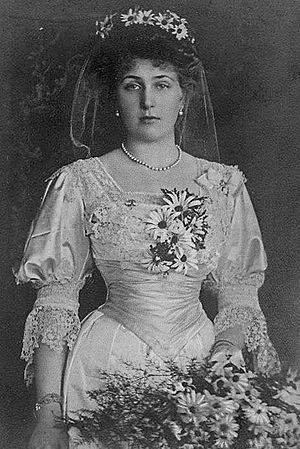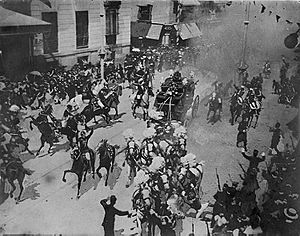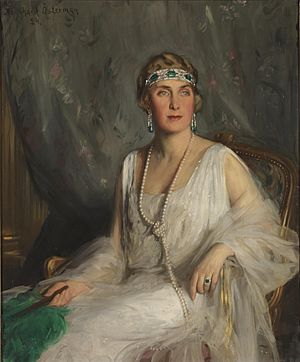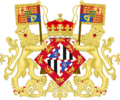Victoria Eugenie of Battenberg facts for kids
Quick facts for kids Victoria Eugenie of Battenberg |
|||||
|---|---|---|---|---|---|
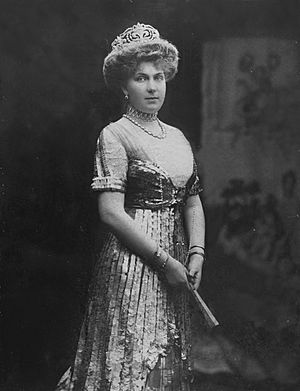
Formal photo portrait by Kaulak, c. 1910
|
|||||
| Queen consort of Spain | |||||
| Tenure | 31 May 1906 – 14 April 1931 | ||||
| Born | 24 October 1887 Balmoral Castle, Scotland |
||||
| Died | 15 April 1969 (aged 81) Lausanne, Switzerland |
||||
| Burial | 18 April 1969 Sacré Coeur Catholic Church, Lausanne, Switzerland 25 April 1985 El Escorial, Spain |
||||
| Spouse | |||||
| Issue |
|
||||
|
|||||
| House | Battenberg | ||||
| Father | Prince Henry of Battenberg | ||||
| Mother | Princess Beatrice of the United Kingdom | ||||
Victoria Eugenie Julia Ena of Battenberg (born October 24, 1887 – died April 15, 1969) was the Queen of Spain. She was married to King Alfonso XIII. Their marriage lasted from May 31, 1906, until April 14, 1931. This was when Spain became a republic.
Victoria Eugenie was a princess from the Hesse region. She was part of the Battenberg family. This family was a branch of the House of Hesse-Darmstadt. She was also the youngest granddaughter of Queen Victoria. Unlike some other Battenberg family members, she was born with the title of Highness. This was because Queen Victoria issued a special order in 1886.
Contents
Early Life
Princess Victoria Eugenie of Battenberg was born on October 24, 1887. Her birthplace was Balmoral Castle in Scotland. Her father was Prince Henry of Battenberg. Her mother was Princess Beatrice of the United Kingdom. Princess Beatrice was the youngest daughter of Queen Victoria of the United Kingdom.
Victoria Eugenie was the last grandchild of a British monarch born in Scotland. Her father, Prince Henry, was from a family that married outside of royal rules. Because of this, his children would normally have a lower royal title. However, Queen Victoria gave Victoria Eugenie the higher title of "Her Highness Princess Victoria Eugenie of Battenberg."
She was named after her grandmother Victoria. She was also named after her godmother, Eugénie de Montijo, a French empress who lived in the UK. Her family and the public called her Ena. She was born in Queen Victoria's 50th year as queen, so she was called "the Jubilee baby."
She grew up in Queen Victoria's home. Her mother, Princess Beatrice, had agreed to stay with the Queen as her companion. So, Victoria Eugenie spent her childhood at Windsor Castle, Balmoral, and Osborne House. She was a bridesmaid at the wedding of her cousins, the Duke of York (who later became King George V) and Duchess of York, in 1893.
When she was six, Victoria Eugenie had a bad accident. She fell off her pony and hit her head. Doctors were worried about her. Her aunt said it was "so grievous that [Victoria Eugenie] cannot take notice or open her eyes."
Victoria Eugenie was very close to her grandmother, Queen Victoria. She said that Queen Victoria was "like a second mother to us." She described her as "very kind but very strict." Queen Victoria loved her grandchildren and called Victoria Eugenie "the little treasure."
Her father died in 1896 from a fever he caught in Africa. After Queen Victoria died in 1901, the Battenberg family moved to Kensington Palace in London.
Engagement to the King

In 1905, Alfonso XIII, the King of Spain, visited the United Kingdom. Victoria Eugenie's uncle, King Edward VII, held a dinner for the Spanish King. Alfonso noticed Victoria Eugenie and asked about her.
King Alfonso was looking for a wife. Many thought he would marry Princess Patricia of Connaught. But Princess Patricia was not interested in him. So, Alfonso became interested in Victoria Eugenie. He sent her postcards and spoke highly of her.
Alfonso's mother, Queen Maria Cristina, was not happy with his choice. She thought the Battenberg family was not royal enough. Also, there were two main problems:
- Religion: Alfonso was Catholic, and Victoria Eugenie was Anglican.
- Health: Victoria Eugenie's brother had haemophilia. This was a bleeding disorder that Queen Victoria had passed on to some of her family. There was a chance Victoria Eugenie could carry the gene. This meant her children could also have the disease.
Despite these worries, Alfonso still wanted to marry her.
After a year of talks, Alfonso's mother finally agreed in January 1906. Princess Beatrice and Victoria Eugenie went to Biarritz, France. King Alfonso met them there. After a few days, they went to San Sebastián to meet Queen Maria Cristina.
Victoria Eugenie then went to Versailles to learn about the Catholic faith. She agreed to convert to Catholicism to become the Queen of Spain. Her official conversion happened on March 5, 1906.
The marriage details were set in two agreements. One was a public treaty between Spain and the United Kingdom. The other was a private agreement. The treaty stated that Victoria Eugenie would lose her right to the British throne. This was because she was marrying a Catholic and becoming Catholic herself. However, her children who were not Catholic could still be in line for the British throne.
Queen of Spain
Princess Victoria Eugenie married King Alfonso XIII in Madrid on May 31, 1906. Her mother and brothers were there, along with her cousins, the Prince and Princess of Wales.
After the wedding, as the royal carriage returned to the palace, a bomb was thrown. An anarchist named Mateu Morral tried to assassinate the King and Queen. Victoria Eugenie was saved because she turned her head to look at a church at that exact moment. She was not hurt, but her dress was stained with blood from a guard. A statue in Madrid now remembers the victims of this bombing.
After this difficult start, Victoria Eugenie felt alone in Spain. She was not very popular at first. Her marriage seemed to get better when she gave birth to a son, Alfonso, who would be the next king.
Sadly, the young prince had haemophilia. This meant Victoria Eugenie was a carrier of the disease. Her oldest and youngest sons inherited it. It is said that King Alfonso never truly forgave Victoria Eugenie for this.
King Alfonso XIII and Queen Victoria Eugenie had seven children in total: five sons and two daughters. Their daughters did not carry the haemophilia gene.
Over time, Victoria Eugenie's relationship with Alfonso became difficult. He had other relationships. This was very painful for the Queen.
Victoria Eugenie focused her energy on helping others. She worked for hospitals and services for the poor. She also helped with education. She was important in reorganizing the Spanish Red Cross. In 1929, a statue of her in a nurse's uniform was put up in Barcelona to honor her Red Cross work.
Many places in Spain were named after her. For example, a bridge in Madrid was named "Puente de la Reina Victoria" in 1909. In 1912, the "Teatro Victoria Eugenia" in San Sebastián was named after her. In 1920, she launched a Spanish Navy ship named Reina Victoria Eugenia.
She received many honors. In 1923, the Pope gave her the Golden Rose. This was the first time a British princess had received this honor since 1555. Her grandmother, Queen Victoria, also gave her the Royal Order of Victoria and Albert.
Exile
The Spanish royal family had to leave Spain on April 14, 1931. This happened after elections brought new leaders to power in many cities. Spain became the Second Spanish Republic. Alfonso XIII hoped that leaving would prevent a civil war.
The family first lived in France, then in Italy. Victoria Eugenie and Alfonso later separated. She lived in the UK and Switzerland. She bought a large house called the Vieille Fontaine near Lausanne.
In 1938, the family met in Rome for the baptism of her grandson, Juan Carlos. On January 15, 1941, Alfonso gave up his rights to the Spanish crown to his son, the Count of Barcelona. Alfonso died on February 28, 1941.
In 1942, Victoria Eugenie had to leave Italy. The Italian government did not want her there because she seemed to support the Allied side in World War II.
Victoria Eugenie returned to Spain for a short visit in February 1968. She was the godmother at the baptism of her great-grandson, Infante Felipe. Felipe later became King of Spain in 2014.
Death
Victoria Eugenie died in Lausanne, Switzerland, on April 15, 1969. She was 81 years old. This was exactly 38 years after she had left Spain. She was the last living child of Princess Beatrice of the United Kingdom.
Her funeral was held in the church of Sacré Coeur. She was buried in the Bois-de-Vaux cemetery nearby. On April 25, 1985, her remains were moved back to Spain. She was re-buried in the Royal Vault at the Escorial, near Madrid. She rests next to her husband, Alfonso XIII, and her sons.
Legacy
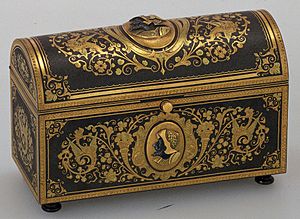
After the Spanish dictator Francisco Franco died in 1975, the monarchy was brought back. Victoria Eugenie's grandson, Juan Carlos I, became King of Spain. Her great-grandson, Felipe VI, is the current king.
Victoria Eugenie had many famous godchildren. These included the Prince of Monaco and Queen Fabiola of Belgium.
Her beautiful Cartier tiara (a jeweled headpiece) was passed down to her daughter, Infanta Maria Cristina of Spain. This tiara is now worn by the Queen of Spain. Another important tiara, the Ansorena fleur-de-lis tiara, was given to her by Alfonso XIII for their wedding. It is now a very important piece in the Spanish Royal collection. The Queen of Spain wears it for special events.
A sapphire ring that belonged to Victoria Eugenie was sold for $50,000 in 2012. That same year, a diamond and pink shell bracelet by Cartier that she owned was sold for $3.4 million.
Images for kids
Issue
| Name | Birth | Death | Notes |
|---|---|---|---|
| Alfonso, Prince of Asturias | 10 May 1907 | 6 September 1938 (aged 31) | He gave up his right to the Spanish throne in 1933. He died in a car crash in 1938. |
| Infante Jaime, Duke of Segovia | 23 June 1908 | 20 March 1975 (aged 66) | He gave up his right to the Spanish throne in 1933 due to health reasons. |
| Infanta Beatriz of Spain | 22 June 1909 | 22 November 2002 (aged 93) | She married Alessandro Torlonia in 1935. |
| Infante Fernando | 21 May 1910 | 21 May 1910 (aged 0) | Born stillborn. |
| Infanta María Cristina of Spain | 12 December 1911 | 23 December 1996 (aged 85) | She married Enrico Eugenio Marone-Cinzano in 1940. |
| Infante Juan, Count of Barcelona | 20 June 1913 | 1 April 1993 (aged 79) | He was recognized as the next in line for the Spanish throne. He married Princess María de las Mercedes in 1935. They had children, including Juan Carlos I of Spain. |
| Infante Gonzalo | 24 October 1914 | 13 August 1934 (aged 19) | He also had haemophilia. He died in a car accident in Austria. |
See also
 In Spanish: Victoria Eugenia de Battenberg para niños
In Spanish: Victoria Eugenia de Battenberg para niños


